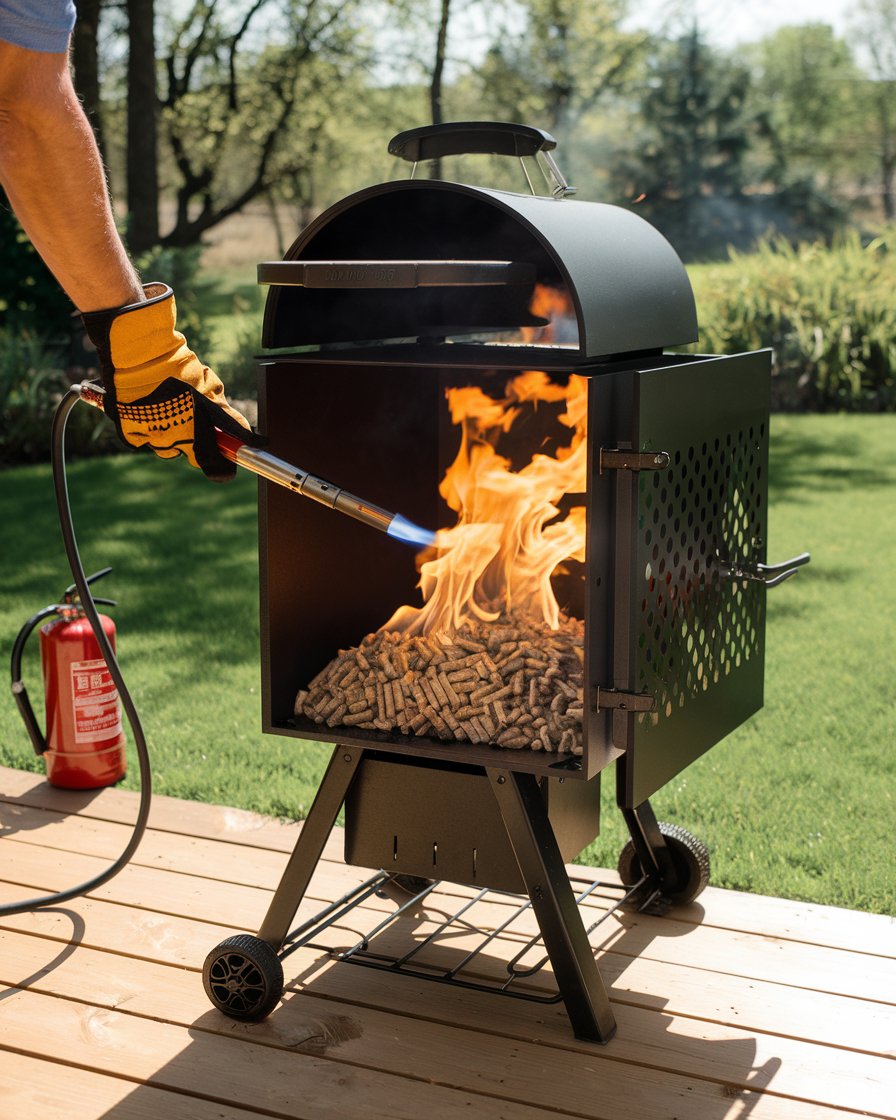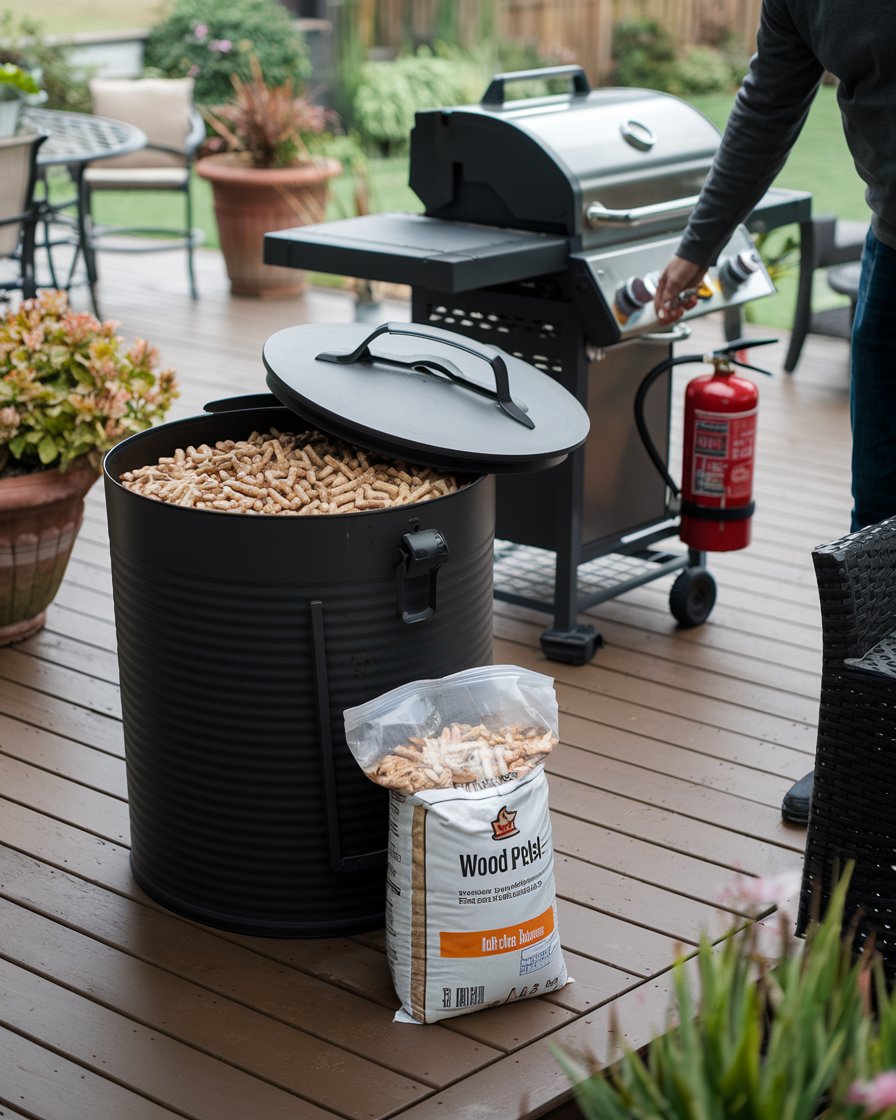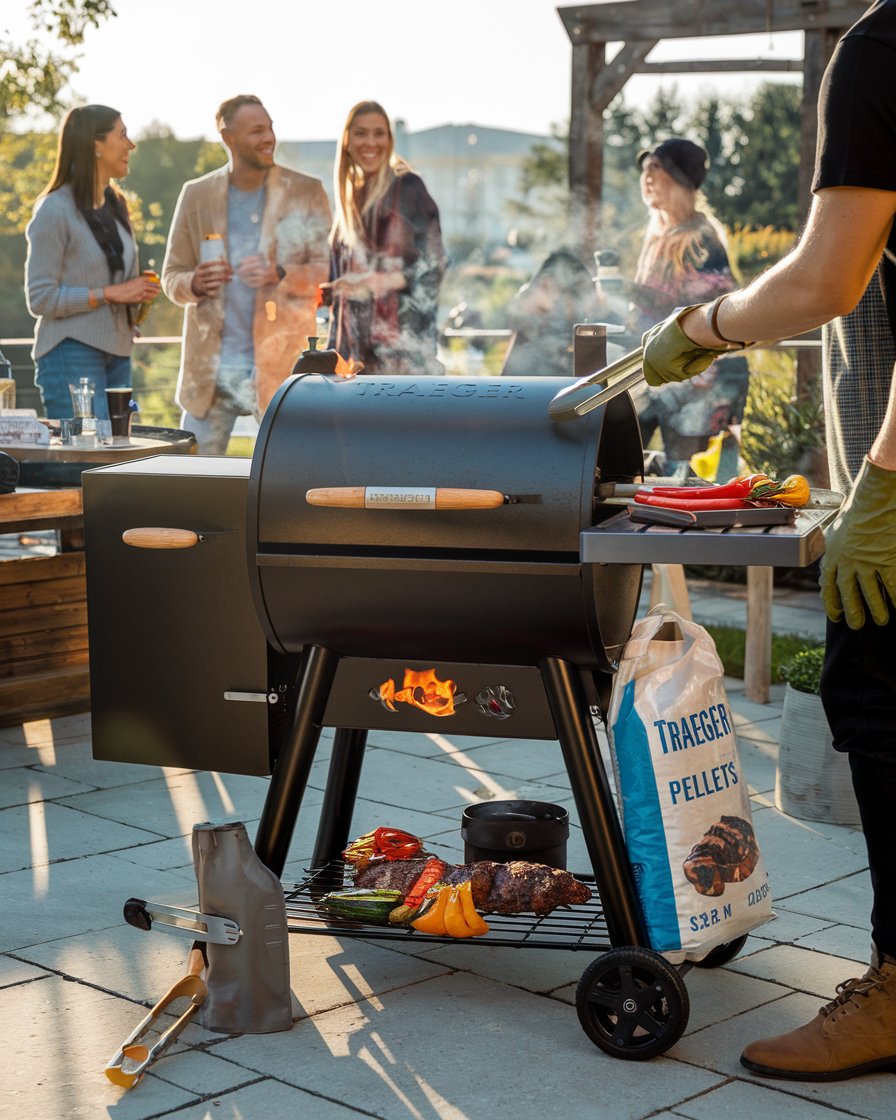Introduction
When it comes to grilling, understanding how to light wood pellets safely is the first step to a successful cookout. Wood pellets, made from compressed sawdust, are a versatile type of fuel used in grills, pellet stoves, and even fireplaces. Whether you’re using Traeger wood pellets or another brand, it’s important to follow the manufacturer’s instructions to ensure proper ignition. Start by filling the hopper with the right amount of pellets, then use a fire starter or propane torch to ignite the pellets evenly. Ensuring proper ventilation will help the fire burn steadily without excessive smoke or ash.
Wood pellets also come from a variety of woods, offering different flavors for your grill. Burning wood pellets efficiently is key to maintaining consistent warmth and cooking performance. As the fire starts, make sure to check the airflow and adjust as needed for an even burn. This process not only creates an enjoyable outdoor cooking experience but also maximizes the versatility of your appliance, whether it’s a pellet grill or a smoker.
Key Takeaways
- Follow the manufacturer’s instructions to ensure safe and efficient ignition when lighting wood pellets for grilling.
- Use a propane torch or fire starter to ignite the pellets evenly, avoiding lighter fluids that may cause flare-ups.
- Ensure proper ventilation to help the fire burn steadily and reduce the risk of safety hazards or excessive smoke.
- Maintaining a steady pellet level in the hopper is key for consistent heat during grilling.
- Choosing different types of wood pellets can enhance the flavor of your food, offering versatility in grilling.
- Proper storage and handling of wood pellets, keeping them dry and free from moisture, is essential for optimal performance.
How to Light Wood Pellets Safely for Your Grill

Lighting wood pellets safely is crucial for achieving a perfect grilling experience. First, gather the necessary equipment such as a torch or fire starter, and follow the manufacturer’s instructions to avoid hazards. Wood pellets are made from compressed sawdust, and they ignite easily when exposed to a steady heat source. To light the pellets efficiently, place them in the pellet grill, ensure proper ventilation, and light a match or use a propane torch. Keep flammable materials like twigs or paper away from the flame to prevent accidents. Once the fire burn starts, maintain it by adding more pellets as needed.
How to Light Wood Pellet Fire for Grill and Feast: Essential Steps for Safe and Efficient Grilling
1. Select the Right Fire Starter
Choosing the proper fire starter is key to lighting wood pellets safely. Avoid using lighter fluid, as it can create flare-ups and alter the flavor of your food. A propane torch or a fire cube designed for pellet grills ensures a more controlled and even ignition.
2. Ensure Adequate Ventilation
For a successful wood pellet fire, ventilation is essential. Open all the vents in your grill to allow oxygen to reach the fire, helping it ignite efficiently. Proper airflow prevents the fire from smoldering and creates an even burn, which is crucial for maintaining consistent cooking heat.
3. Use High-Quality Wood Pellets
Opt for high-quality wood pellets made from compressed sawdust, as they ignite more easily and burn longer. Different types of wood, like cherry or oak, offer unique flavors to enhance your grilling experience. Always ensure your pellets are dry to avoid difficulties with ignition and to maintain a steady fire.
4. Monitor and Maintain Pellet Levels
To keep the fire burning consistently, it’s important to regularly monitor the pellet levels in your hopper. Wood pellets burn steadily, but a depleted hopper can cause the fire to lose intensity. Refilling as needed ensures your grill continues to produce the ideal cooking temperature.
5. Keep Flammable Materials Away
When lighting wood pellets, always keep twigs, paper, or other flammable materials away from the fire to avoid unnecessary risks. Maintaining a clear and safe area around the grill helps prevent accidents and ensures that your grilling experience remains focused on food rather than fire hazards.
6. Follow Manufacturer’s Instructions for Safety
Every pellet grill may have specific requirements, so it’s critical to follow the manufacturer’s instructions closely. This includes the right way to ignite the pellets, manage airflow, and safely extinguish the fire. Following these guidelines ensures you have an enjoyable and safe grilling experience.
Choosing the Right Equipment for Lighting Wood Pellets
To light wood pellets safely, selecting the right equipment is essential. A propane torch or fire starter is often recommended for ease of use and efficiency. These tools provide a controlled flame, allowing you to light the pellets evenly and quickly. It’s important to avoid using lighter fluid, as it can create flare-ups and impact the flavor of your food. Instead, opt for tools designed specifically for pellet grills. Ensure the pellets are placed in the grill with proper ventilation, allowing the fire to start cleanly and burn evenly without excessive smoke or ash.
Ensuring Proper Ventilation When Lighting a Wood Pellet Fire
Proper ventilation is crucial when lighting wood pellets, as it directly affects how the fire burns. Without adequate airflow, the fire may struggle to ignite or produce thick smoke. When using a pellet grill, check that the vents are open and free from obstructions before lighting. Ventilation allows the fire to burn more efficiently by providing the necessary oxygen flow. If you’re lighting pellets in an enclosed space like a stove, use the appliance’s built-in airflow system to regulate the burn. Proper ventilation not only improves the fire but also reduces the risk of safety hazards.
The Best Way to Use Wood Pellets for a Consistent Fire

To maintain a consistent fire when using wood pellets, proper setup is key. Start by ensuring your pellet grill is clean and free from ash or residue. Wood pellets come from various types of wood like cherry and oak, each adding unique flavors to your grill. Fill the hopper with enough pellets, and light them using a reliable fire starter or torch. The pellets will smolder and produce an even burn, creating the perfect environment for cooking. Make sure to soak some wood chips if necessary to enhance the smoking process, and monitor the fire to ensure it remains consistent throughout.
Case Study: Optimizing Wood Pellet Usage for Consistent Heat and Flavor
In a 2021 case study conducted by Traeger Grills, researchers examined the impact of different wood pellet types on maintaining consistent heat and flavor profiles during extended grilling sessions. The study focused on two groups of pitmasters: one group used cherry wood pellets, known for their mild flavor, while the other used a combination of oak and hickory, which provide a stronger, smoky taste.
The findings showed that the group using a mix of oak and hickory pellets achieved more consistent heat throughout the grilling process, maintaining the fire for longer periods without the need for frequent refueling. Meanwhile, the cherry pellet group needed to add more pellets regularly to maintain an even burn. The study emphasized that the type of wood pellets used directly affects both flavor and fire consistency, highlighting the importance of selecting the right pellets based on grilling needs.
Maintaining Pellet Levels for Consistent Heat
To maintain a consistent fire using wood pellets, monitoring the pellet levels in your grill’s hopper is essential. Wood pellets burn steadily, but once the hopper runs low, the fire may lose intensity. To avoid interruptions, fill the hopper with enough pellets before starting the fire. Some pellet grills have sensors to alert you when levels are low, but manually checking is always a good practice. Consistent heat relies on a steady flow of pellets, so keep an eye on the fuel to ensure your grill performs optimally throughout the cooking process.
Using Different Types of Wood Pellets to Control Flavor
Wood pellets come in various types, each offering unique flavor profiles that enhance your grilling. Cherry, oak, and hickory pellets are popular choices, with each adding a distinct smoky flavor to the food. When using wood pellets, consider the type of food you’re grilling and select pellets that complement it. Lighter woods like cherry are ideal for delicate meats like chicken, while stronger woods like hickory work well with beef or pork. Combining different types of pellets can also add complexity to the flavor, making your grilling experience more versatile.
Precautions When Lighting a Wood Pellet Fire for Grilling

Taking the right precautions when lighting wood pellets can prevent accidents and ensure a smooth grilling experience. Always use wood pellets in well-ventilated areas to reduce the risk of carbon monoxide buildup. Follow the manufacturer’s instructions for lighting and handling the pellets, and keep a fire extinguisher nearby just in case. Avoid overloading the grill with pellets, as this can cause excessive smoke and increase the fire hazard. Make sure to store wood pellets in a dry container to prevent moisture, which can make them difficult to light and maintain. With these precautions, your pellet fire will burn safely.
Avoiding Common Hazards When Lighting Pellets
Lighting wood pellets requires attention to safety to avoid common hazards. One of the biggest risks is improper storage, as wet pellets can become difficult to ignite and create excessive smoke. Store pellets in a dry, sealed container to prevent moisture buildup. Additionally, avoid overloading the grill, as too many pellets can block airflow, leading to inefficient burning. It’s also important to keep flammable materials, like paper or kindling, away from the fire to reduce the risk of flare-ups. Following these basic safety guidelines can help prevent accidents and ensure a smooth grilling process.
Proper Storage and Handling of Wood Pellets
Storing wood pellets correctly can make a significant difference in their performance. Pellets should be kept in a dry location, as moisture can cause them to swell and become unusable. A sealed container is ideal for protecting them from humidity and damp environments. Additionally, handling pellets with care is important, as they are made from compressed sawdust and can break easily. When transferring pellets to the hopper, do so gently to avoid unnecessary dust, which can affect how evenly they burn. Proper storage and handling not only extend the lifespan of your pellets but also improve grilling efficiency.
“An ounce of prevention is worth a pound of cure.” – Benjamin Franklin
Tips to Keep a Fire Burning with Traeger Pellets

Once your wood pellet fire is lit, keeping it going requires attention to detail. Use high-quality Traeger pellets, which burn efficiently and provide a steady flame. Check the hopper regularly to ensure it has enough fuel, and add more pellets when necessary to keep a fire burning consistently. Adjust the air vents to maintain proper airflow, as this helps the fire burn evenly. If the fire begins to smolder or produce too much smoke, stir the pellets to ensure they are burning correctly. Following these tips will result in a successful grilling experience.
Using the Right Amount of Traeger Pellets for Optimal Burning
Using the correct amount of Traeger pellets is key to maintaining a consistent fire. Too few pellets, and the fire may go out prematurely; too many, and it may smolder rather than burn evenly. Start by filling the hopper with enough pellets to last the duration of your grilling session. Regularly check the levels and add more pellets as needed to keep the fire burning steadily. Traeger pellets are known for their high heat and even burn, making them an excellent choice for long grilling sessions where maintaining temperature is important.
Adjusting Airflow for Better Pellet Burn Performance
Proper airflow is essential for keeping your fire burning with Traeger pellets. Adjusting the vents on your grill controls how much oxygen reaches the fire, which in turn affects how evenly the pellets burn. Open vents will allow more oxygen, increasing the heat and intensity of the fire, while closing them slightly can reduce the burn rate for longer cooking times. Monitoring and adjusting the airflow helps you maintain control over the fire, preventing flare-ups or smoldering. With the right airflow, Traeger pellets will burn efficiently and provide consistent heat for your grilling.
Conclusion
Lighting wood pellets properly is the foundation of a successful grilling experience. Using a propane torch or fire starter ensures an even ignition while keeping safety a priority by following the manufacturer’s instructions. Wood pellets are a great choice for consistent heat, providing warmth and a steady burn. Maintaining proper airflow and adjusting the grill vents will help create an even burn, ensuring the fire stays lit throughout the grilling process. Additionally, wood pellets come in a variety of types, offering different flavors, and Traeger pellets are a top choice for their long-lasting and efficient performance.
To optimize your grilling experience, always store wood pellets in a dry area to prevent moisture from affecting the burn. Filling the hopper with the right amount of pellets and using tools like a chimney starter or a cube for ignition will help keep the fire going. With these practices, you’ll be able to enjoy safe, flavorful, and consistent grilling on your patio every time.


